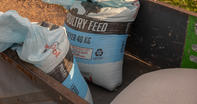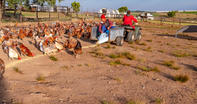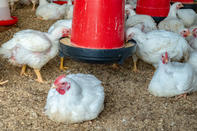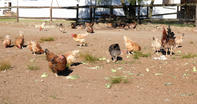
Pool Resources

Buying small volumes of feed through a middleman drives up costs. To overcome this problem, Dr Charlotte Nkuna of the South African Poultry Association suggested in a Farmer’s Weekly article that farmers pull resources and buy inputs, such as chicks, feed, vaccines and bedding, in bulk directly from suppliers, such as feed mills or hatcheries.
This might not always be practical when farmers are located far apart, but farmers should talk to one another and together try to come up with creative solutions to these challenges.
Avoid Poor Quality Feed
When buying feed, ensure you buy it from a reputable source. The problem with substandard feed is that it might result in nutritional deficiencies that can lead to poor production, growth and render birds more vulnerable to diseases.
Stale food may also lead to certain diseases. Ideally the feed should be of a good quality that is targeted to the needs of your animals.
Feed for broilers, for example, should have a higher energy and protein content than feed for layers, since broilers are required to gain weight faster than layers. So what is good quality food?
- The feed should be free from toxins and harmful substances.
- It should be fresh and mould free. It should not smell bad or off and it should look fresh.
- It should be developed from good quality ingredients.
- Products should be uniform and not vary from one batch to another.
- There should be a batch number, date of manufacturing and contacts to allow easy traceability when something goes wrong.
Correct Storage

- Feed has to be kept dry, cool, out of direct sunlight and in a well ventilated space.
- It should be protect from vermin and other insect pests, not only to prevent feed losses, but also because these pests can contaminate the feed.
- Feed should preferably be kept off the ground, to prevent ground condensation
- It should be stored away from chemicals and drugs.
- If kept in bins, the bins should be properly cleaned before new feed is added to it.
- Storage areas should be kept clean.
Make Your Own

If you have access to good quality ingredients, such a maize, soya, fishmeal, maize bran and sunflower, you may produce your own feed.
Ask an extension officer or animal nutritionist to help you formulate a balanced ration that addresses the nutritional demands of your birds at different stages of production. In an article on the Poultrysite.com, Jan Grobbelaar of Dumela Poultry Solutions have the following tips for farmers who cannot afford to buy feed. Firstly, they can produce their own fly larvae to feed the birds.
This can be done by placing rotten food scraps, such as cabbage, in a bucket that is suspended on a pole. The food scraps will attract flies, which will lay their eggs in it. Holes should be made at the bottom of the bucket, so the larvae, which will move to the bottom of the bucket will fall through the holes.
Another bucket can be placed below the larvae producing bucket to catch the larvae. A second alternative is to harvest termites. For sustainable production, Grobbelaar teaches farmers to remove only part of the termite nest by making a hole in it.
The hole is then covered up with dry grass to accelerate the restoration of the nest. It takes nine months before a nest can be harvested again. Another alternative is to supply mouldy maize that is not fit for human consumption to birds.
Although this present a disease risk, the risk is lower for scavenging chicken as they are much hardier than modern commercial birds and able also able to stomach certain foods better.
By Glenneis Kriel